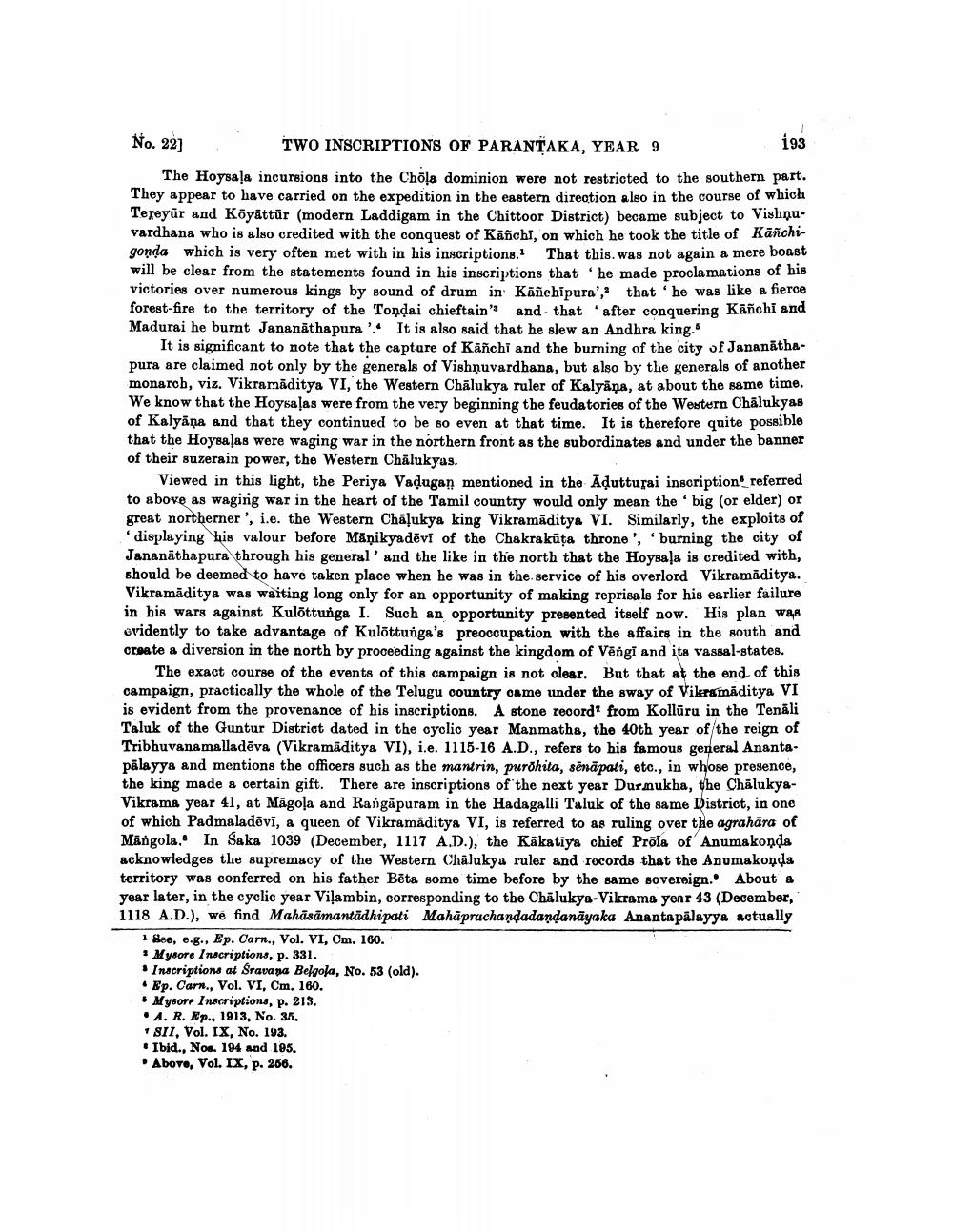________________
No. 22] TWO INSCRIPTIONS OF PARANTAKA, YEAR 9
193 The Hoysala incursions into the Chola dominion were not restricted to the southern part. They appear to have carried on the expedition in the eastern direction also in the course of which Tereyür and Köyáttür (modern Laddigam in the Chittoor District) became subject to Vishnuvardhana who is also credited with the conquest of Kāñchi, on which he took the title of Kanchagonda which is very often met with in his inscriptions. That this was not again a mere boast will be clear from the statements found in his inscriptions that he made proclamations of his victories over numerous kings by sound of drum in Kanchipura', that he was like a fierce forest-fire to the territory of the Tondai chieftain'and that after conquering Kanchi and Madurai he burnt Jananáthapura'. It is also said that he slew an Andhra king.
It is significant to note that the capture of Kāñchi and the burning of the city of Jananāthapura are claimed not only by the generals of Vishnuvardhana, but also by the generals of another monarch, viz. Vikramaditya VI, the Western Chalukya ruler of Kalyaņa, at about the same time. We know that the Hoysalas were from the very beginning the feudatories of the Western Chalukyas of Kalyäņa and that they continued to be so even at that time. It is therefore quite possible that the Hoysalas were waging war in the northern front as the subordinates and under the banner of their suzerain power, the Western Chalukyas.
Viewed in this light, the Periya Vadugan mentioned in the Adutturai inscription referred to above as wagirig war in the heart of the Tamil country would only mean the big (or elder) or great northerner', i.e. the Western Chalukya king Vikramaditya VI. Similarly, the exploits of "displaying his valour before Mänikyadēvi of the Chakrakūta throne', 'burning the city of Jananāthapura through his general' and the like in the north that the Hoysala is credited with, should be deemed to have taken place when he was in the service of his overlord Vikramaditya. Vikramāditya was waiting long only for an opportunity of making reprisals for his earlier failure in his wars against Kulöttunga I. Such an opportunity presented itself now. His plan w2,8 evidently to take advantage of Kulöttunga's preoccupation with the affairs in the south and create a diversion in the north by proceeding against the kingdom of Vēngi and its vassal-states.
The exact course of the events of this campaign is not clear. But that at the end of this campaign, practically the whole of the Telugu country came under the sway of Vikramaditya VI is evident from the provenance of his inscriptions. A stone record from Kollūru in the Tenāli Taluk of the Guntur District dated in the cyclic year Manmatha, the 40th year of the reign of Tribhuvanamalladēva (Vikramāditya VI), i.e. 1115-16 A.D., refers to his famous general Anantapälayya and mentions the officers such as the mantrin, purðhita, sēnāpati, etc., in whose presence, the king made a certain gift. There are inscriptions of the next year Durmukha, the ChālukyaVikrama year 41, at Mägola and Rangāpuram in the Hadagalli Taluk of the same District, in one of which Padmaladēvi, a queen of Vikramaditya VI, is referred to as ruling over the agrahāra of Mängola, In Saka 1039 (December, 1117 A.D.), the Kakatiya chief Prõla of Anumakonda acknowledges the supremacy of the Western Chalukya ruler and rocords that the Anumakonda territory was conferred on his father Bēta some time before by the same sovereign. About a year later, in the cyclic year Viļambin, corresponding to the Chalukya-Vikrama yenr 43 (December, 1118 A.D.), we find Mahāsāmantādhipati Mahāprachandadandanayaka Anantapälayya actually
1 See, e.g., Ep. Carn., Vol. VI, Cm. 160. : Mysore Inscriptions, p. 331. • Inscriptions at Sravana Belgola, No. 53 (old). • Ep. Carn., Vol. VI, Cm. 160. Mysore Inscriptions, p. 213.
A. R. Ep., 1913, No. 34. + SII, Vol. IX, No. 193. • Ibid., Nos. 194 and 195. . Above, Vol. IX, p. 256.




